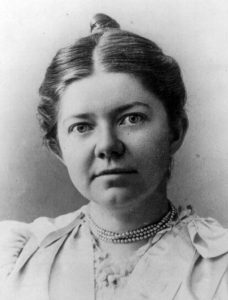
Amy Beach
Music Period: Romantic
Location: New Hampshire, USA
Claim to Fame: one of the few women to have found a place in mainstream histories of music.
Amy Beach (neé Cheney) was an entirely self-taught composer born in New Hampshire in 1867. This incredible woman played music mainly by ear, and was composing short pieces of music by the age of four. Any’s mother encouraged her daughter to grow by giving her piano lessons three times a week. In 1875, at the age of seven, Amy made her first appearance in public performing one of her own pieces at a church concert. It was the first concerts of many she would play.
Soon after her first performance the family moved to Boston, where Amy attended a private school. Amy took formal piano lessons at this time, alongside a few harmony lessons. This would be the only music theory teaching Amy would have in her lifetime. The rest she would learn herself. To learn orchestration, for example, Amy spent hours and hours translating treatises before engaging herself with musical comparison between her own works and those of others.
In 1883, Amy made her debut as a pianist with a Boston orchestra. The same year saw her first published work, a song titled “The Rainy Day”. Two years later, Amy performed with the Boston Symphony Orchestra for the first time, and met publisher Arthur Schmidt. This meeting led to the beginning of a long professional relationship between the two after he published her “With Violets” song. Arthur would go on to publish most of the music Amy wrote, including her less-profitable orchestral works.
At the age of 18, Amy married successful physician Dr. Henry Harris Aubery Beach. Like many women of her class, Amy stopped performing in public after her marriage. The only performances she gave were special appearances at charity concerts. She did, however, continue to compose – and always under the name Mrs H.H.A. Beach. Unusually for the period, Amy was encouraged to continue writing music by her husband, who was a keen amateur musician. This paved the way for Amy to produce larger-scale works alongside the popular song and piano pieces she wrote. We see some of her most accomplished works written during the 1890s, as well as some of her most popular songs. One of these popular songs was “Ecstasy” (1892), which was written to her own words. It was during this time that her Mass in E flat (op.5) was premiered to audiences in Boston. This piece carried a youthful and joyous but dramatic sound, and much of the music produced during this period contained expansive melodies and rich harmonies.
The popularity of Amy’s music led the way for the president of the Board of Lady Managers, Bertha Palmer, to ask Amy to write a work for the dedication ceremonies taking place at the World’s Columbian Exposition in Chicago. However, the decision was overruled by the all-male Bureau of Music, and Festival Jubilate was refused for the programme. The piece was later played at the opening of the Women’s Building at the Exposition in 1893, alongside music from other female composers. In the same year, Amy started work on her “Gaelic” Symphony in E minor, which was premiered by the Boston Symphony Orchestra in 1896. It was the first symphony written by an American woman and critics praised the work.
In 1910, Amy’s husband died, and the following year she resumed her performing career. Amy embarked on a successful tour of Europe playing her piano works to large audiences until 1914, when she returned to the USA and settled in New York. Whilst there, she established a routine that included a busy performance schedule during the winter, and time for composition over the summer. By the 1920s, her music was hugely popular, and Amy Beach clubs appeared all over America.
For Amy, music was always central to her life, and “mean[t her] inner soul”. The music she composed ranges from popular songs of the time through to large-scale orchestral works, and those later works influenced by folk music from around the world. Unlike many, this incredible woman continued to compose and publish music after her marriage in 1885. She also led the way for women composers throughout America. It was only towards the end of her life, however, that female composers gained more recognition for their contributions to the music world. Amy became the first president of the newly created Society of American Women Composers in 1924, and with it, America‚Äôs first successful woman composer.
-Claire Amundson
Junior Girl
Girl Museum Inc.
